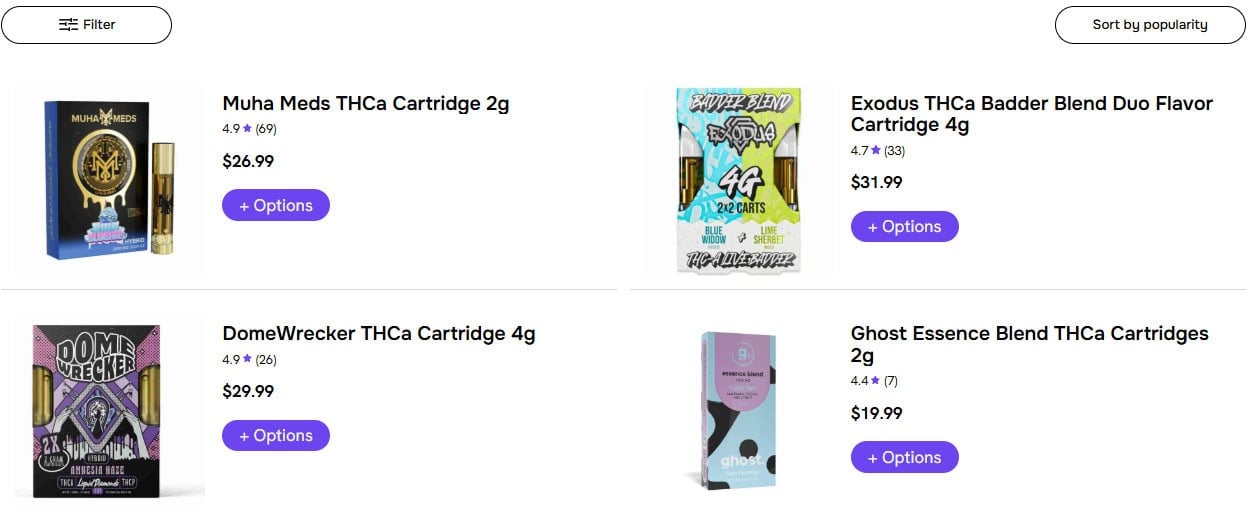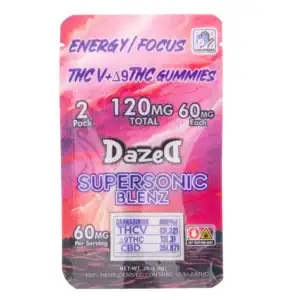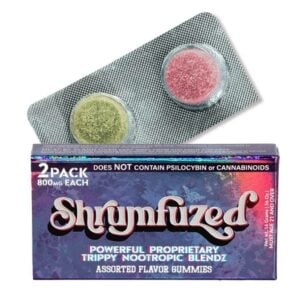Is It Bad to Smoke a Brown Cart? Understanding the Risks and Effects
A “brown cart” is a potentially low-quality or contaminated cannabis vape cartridge, which raises serious health concerns. This is typically down to factors like unknown additives, improper extraction methods, and lack of regulatory testing. Some of its negative effects include lung irritation and severe conditions like EVALI (vaping-associated lung injury).
- Introduction to Vaping
- Understanding THC Oil Composition
- The Vaping Experience
- Health Implications of Vaping
- Identifying Quality THC Cartridges
- Impact of Direct Sunlight and Heat on Vape Cartridge Quality
- Is It Bad to Smoke a Brown Cart?
- Risks of Dark Brown Cartridges
- Vape Cartridge Maintenance and Storage
- Avoiding Counterfeit Vape Products
- Regulation and Standards
- Understanding Shelf Life of Vape Cartridges
- Effects of Temperature Settings on THC Vape Oil
- Recognizing Signs of Expired or Degraded Vape Cartridges
- The Role of Carrier Liquids in Cannabis Vape Oil
- Understanding Dry Hits and How to Prevent Them
- Why Proper Packaging and Labeling Matter in Vape Cartridges
- Additional Resources
As such, knowing what’s in your cart, its sourcing, and consumption habits is critical to minimizing harm. Let’s break down what informs these risks and how you can make safer choices!
Introduction to Vaping
Vaping has become a preferred method of cannabis consumption due to its convenience and portability. Vape pens and THC vape cartridges offer a discreet way to inhale cannabis oil, which is typically found in a concentrated form. These cannabis products are popular among users seeking quick effects without the harshness of smoking cannabis flower.
However, the vaping experience depends on several factors, including the quality of the cannabis oil, the design of the vape cartridge, and the temperature settings of the vape pen. Improper use can result in a burnt taste, dry hits, or reduced potency. A dark brown or expired cartridge may indicate oxidation or poor storage, raising concerns about whether it’s bad to smoke a brown cart.
Many users ask, “Is it bad to smoke a brown cart?” The answer depends on a few factors such as storage conditions, oil composition, and how long the cart has been exposed to air or heat. A brown cart may indicate oxidation or an expired cart, which can affect both potency and flavor. Read on to learn about what this means for you.
Understanding THC Oil Composition
| Aspect | Vape Pens | Cartridges |
|---|---|---|
| THC Concentration | Typically 70–90% THC | Typically 70–95% THC |
| Cannabinoid Profile | May contain THC only or a mix with CBD, CBN, etc. | Often full-spectrum or broad-spectrum cannabinoids |
| Terpene Content | May include added natural or artificial terpenes | Often uses strain-specific terpenes for flavor and effect |
| Additives | Sometimes includes thinning agents (e.g. PG, VG, MCT oil) | Higher-quality carts avoid additives; check lab reports |
| Carrier Oils | May use carriers in low-quality products | Premium carts avoid carriers; use distillate or live resin |
| Extraction Method | CO₂ or solvent-based (butane, ethanol) | Typically CO₂, ethanol, or rosin extraction |
| Purity & Potency | Can vary; check for lab-tested results | More consistent in branded cartridges |
| Flavor Profile | May be flavored artificially or naturally | More likely to mimic strain-specific flavor |
| Consistency & Thickness | Medium to thick oil; viscosity varies with ingredients | Usually thick, amber-colored distillate |
THC oil, used in most cannabis vape cartridges, is a concentrated form of cannabis that contains active compounds like cannabinoids and terpenes. These components are responsible for the oil’s potency, aroma, and flavor, and their specific ratios can greatly influence the vaping experience. The quality and purity of the THC oil play a major role in delivering the desired effects during cannabis consumption.
The oil’s appearance and performance can change due to factors like oxidation, which may naturally darken its color over time. While some dark brown oil is the result of aging, drastic color shifts may indicate that the oil has not been stored properly or has surpassed its shelf life.
Additionally, many THC vape cartridges use thinning agents such as vegetable glycerin to achieve the right consistency for use in vape pens. However, improper formulations or excessive additives can compromise both flavor and safety.
Using high-quality cannabis products ensures smoother vapor, consistent potency, and fewer issues like dry hits or burnt taste. In contrast, cheap materials and poorly manufactured vape carts may expose users to harmful residues or faulty heating elements. For a safe and enjoyable vape, it’s important to choose reliable products, pay attention to oil color and consistency, and consider proper storage and temperature control when vaping cannabis.
The Vaping Experience

A THC cartridge or cannabis cartridge contains cannabis oil or cannabis concentrates designed for vaping. The oil’s quality and composition, including whether carbon dioxide or other extraction methods were used, can greatly impact your vaping experience.
The vaping experience is influenced by several factors, including the quality of the cannabis vape cartridge, temperature settings, and a user’s individual tolerance. Choosing high-quality products and properly adjusting the vape pen can significantly enhance the overall experience.
Many users find vaping cannabis more convenient and discreet than smoking cannabis flower. THC vape cartridges deliver concentrated cannabis oil in a controlled manner, offering a smoother inhale with less odor and quicker effects. This makes vape carts a popular choice for both recreational and medicinal cannabis consumption.
The flavor and potency of THC vape cartridges can vary depending on the oil’s composition and how well the cartridge is made. To avoid burnt taste and dry hits, it’s important to store cartridges properly, use the right temperature settings, and regularly maintain the vape pen. These steps ensure a consistent and enjoyable vape while preserving the oil’s potency and flavor.
Health Implications of Vaping
While vaping cannabis is often considered a cleaner alternative to smoking cannabis flower, it still carries potential health implications. These may include respiratory irritation, lung disease, or other complications, particularly when using low-quality vape cartridges or counterfeit products.
The materials used in cannabis vape cartridges, including the heating element and the cannabis oil itself, play a critical role in determining the safety of the vaping experience.
Temperature settings are especially important when it comes to health risks. High temperatures can degrade THC oil, leading to the formation of harmful byproducts and a burnt taste, while also reducing potency and flavor. In contrast, vaping at lower temperatures can help preserve cannabinoids and terpenes, delivering the desired effects without overheating the oil.
Improper settings or cheap components may also cause dry hits or the release of toxic substances from degraded materials.
To minimize these risks, it’s essential to use high-quality THC vape cartridges and store them properly in a cool, dry location. Preventing oxidation by avoiding exposure to direct sunlight and sealing the vape carts tightly helps maintain oil quality and potency. Understanding these factors can help users make informed choices, ensuring safer cannabis consumption and a more enjoyable vape experience overall.
Identifying Quality THC Cartridges
Choosing high-quality THC vape cartridges is essential for both safety and satisfaction during cannabis consumption. A reliable cartridge ensures that the cannabis oil delivers its intended effects without exposing users to unnecessary risks. Reputable brands typically use properly tested cannabis oil and safe materials that support a smooth and enjoyable vape.
When evaluating a cartridge, pay close attention to packaging, labeling, and branding. Authentic products often include lab test results, batch numbers, and clear ingredient lists. The oil inside should be clear or light in color extremely dark brown or cloudy oil can be a red flag for poor quality or oxidation. A consistent texture and natural scent or flavor also signal a well-made THC vape cartridge oil.
Counterfeit or low-quality vape carts can contain harmful additives, pesticides, or even heavy metals. These products are often made with cheap materials that may degrade under high temperatures, releasing toxic fumes or causing a burnt taste. To avoid these health implications, only purchase THC vape carts from licensed dispensaries or trusted sources, and always inspect the oil and cartridge before use.
Impact of Direct Sunlight and Heat on Vape Cartridge Quality
A brown cart can be a sign of an expired cart one that hasn’t been stored properly. Vape cartridges kept in warm, bright areas for long periods are more likely to degrade, affecting both safety and enjoyment when you consume cannabis.
Exposure to direct sunlight and high temperatures can significantly degrade the quality of THC vape cartridges. Ultraviolet (UV) rays from sunlight accelerate the oxidation process, causing the cannabis oil to darken and lose potency faster.
Heat can also thin the oil excessively or damage the delicate terpenes and cannabinoids, leading to a burnt taste and reduced effectiveness. Storing vape cartridges in a cool, dark place away from heat sources and sunlight is essential to maintain the oil’s integrity and ensure a pleasant vaping experience over time.
Is It Bad to Smoke a Brown Cart?
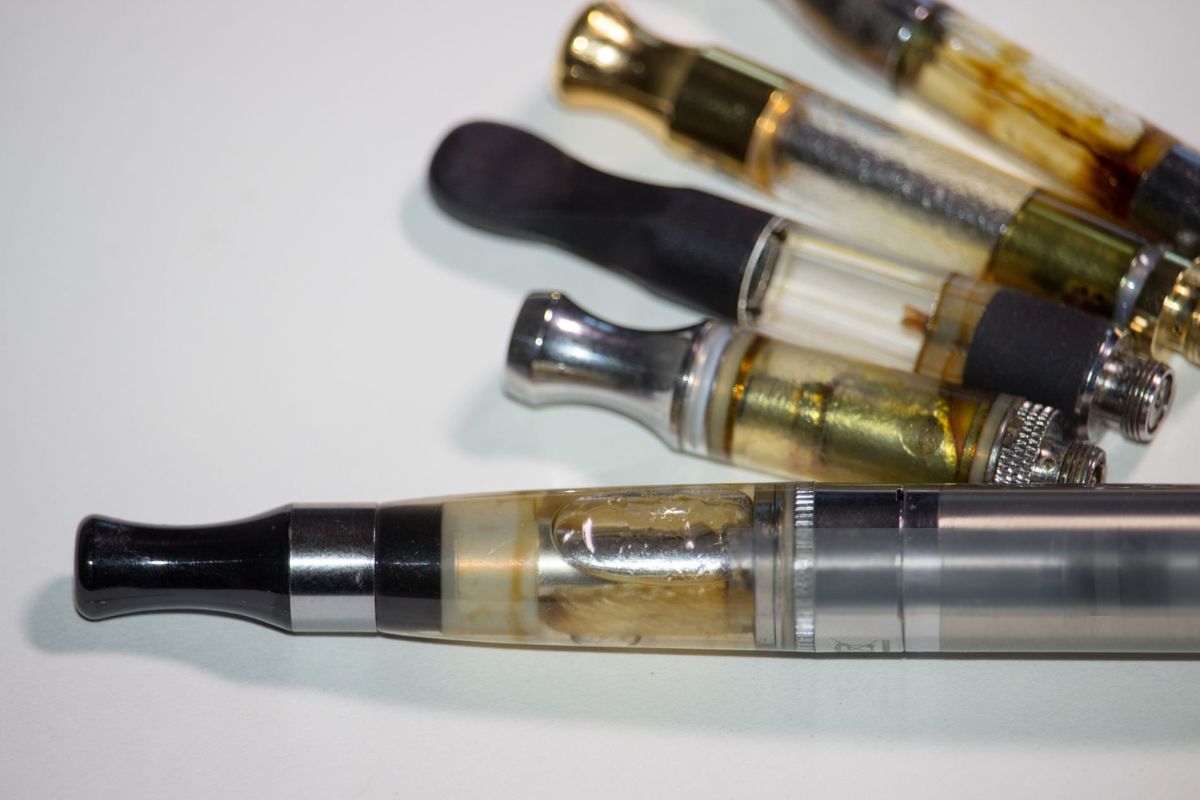
Yes, smoking a brown cart a vape cartridge that has noticeably darkened can be a red flag and may indicate degraded THC oil or an expired cart. While discoloration can occur due to a natural process like oxidation over long periods, it often signals that the cannabis oil has been exposed to heat, light, air, or improper storage conditions.
When THC oil oxidizes, it can lose potency and flavor, making the vaping experience less effective and less enjoyable. The presence of oil droplets that are darker than usual or thick and uneven can also be a sign of separation or contamination. THC carts that turn brown may also produce a burnt taste, particularly if the heating element of the vape pen has repeatedly overheated the oil.
While not all brown oil is necessarily harmful, a few factors must be considered. If the cart has passed its expiration date, or if it emits an unusual smell, taste, or harsh vapor, it is safest not to use it. Additionally, counterfeit or low-quality cannabis cartridges may use cheap materials that degrade faster and pose health implications when vaped.
In summary, while a slightly darker hue may result from natural aging, a significantly brown cart should be treated with caution to avoid inhaling degraded or contaminated oil that could pose respiratory risks.
Risks of Dark Brown Cartridges
Discoloration in vape oil is often the result of a natural process like oxidation. Over long periods, especially with improper storage, THC carts can turn darker and lose their sweet flavors. This doesn’t always mean the oil is unsafe, but it can signal diminished quality.
Dark brown cartridges often indicate that the THC vape cartridge oil has undergone oxidation a natural process that can occur over time, especially if the cartridge hasn’t been stored properly. Oxidation can degrade cannabinoids and terpenes, resulting in a noticeable loss of potency, altered flavor, and a less effective vaping experience. In some cases, users may also detect a burnt taste or dry hits when using an oxidized or expired cartridge.
The health implications of using dark brown vape carts go beyond reduced performance. Prolonged exposure to heat, air, or direct sunlight can cause chemical changes in the oil, potentially creating harmful byproducts. While some discoloration may be harmless, it can also signal contamination or a breakdown of oil quality, especially in products made with cheap materials or thinning agents like vegetable glycerin.
To avoid these issues, it’s crucial to store cannabis vape cartridges in a cool, dark place and monitor the oil’s color and consistency regularly. If a cartridge appears dark brown and has lost its flavor or smoothness, it may be time to replace it. Using fresh, high-quality THC vape cartridges ensures a safer, more enjoyable vape and helps avoid the potential risks associated with degraded cannabis oil.
Vape Cartridge Maintenance and Storage
| Category | Best Practices |
|---|---|
| Storage Temperature | Keep between 60–70°F (15–21°C); avoid extreme heat or cold. |
| Light Exposure | Store in a dark place; UV light can degrade THC and terpenes. |
| Positioning | Keep upright to prevent leakage and maintain oil near the heating element. |
| Seal Integrity | Always recap cartridges when not in use to avoid air exposure and contamination. |
| Cleanliness | Regularly wipe mouthpiece and threads with isopropyl alcohol. |
| Device Compatibility | Use cartridges with matching battery voltage to prevent overheating or burning. |
| Airflow Check | Ensure airflow holes are clear and not clogged with oil or debris. |
| Avoid Overuse | Take short, gentle puffs; avoid chain vaping to preserve coil life. |
| Long-Term Storage | Store in a cool, airtight container if unused for weeks or months. |
| Check Expiration | Most cartridges are good for 6–12 months; check label for date or signs of aging. |
Proper maintenance and storage of THC vape cartridges are essential to preserving the quality, potency, and flavor of the cannabis oil inside. Over time, exposure to air, light, or heat can degrade the oil, leading to a dark brown appearance, a burnt taste, or diminished effects. To avoid these issues, always store vape cartridges in a cool, dark place, away from direct sunlight and high temperatures.
Keeping your cannabis vape cartridges sealed tightly helps prevent oxidation and moisture buildup, both of which can negatively impact the oil’s shelf life. Storage conditions play a major role in maintaining a consistent and enjoyable vape, as even high-quality products can lose potency or flavor if not stored properly. A dry location with stable temperatures is ideal for preserving THC oil and avoiding common problems like oil droplets, leaks, or thickening.
In addition to storage, regular maintenance of your vape pen and cartridge is key. Clean the mouthpiece and connection points to prevent clogs and ensure that the heating element functions efficiently. Proper care helps you get the most out of your vape carts while minimizing potential risks, ensuring a smooth, flavorful vaping experience every time.
Avoiding Counterfeit Vape Products
Counterfeit THC vape cartridges are a growing concern in the cannabis market, posing serious health risks such as lung disease, respiratory irritation, and exposure to toxic chemicals. These fake products often contain low-grade cannabis oil or unregulated additives that can compromise both safety and effectiveness. Many users have reported harmful side effects from using counterfeit vape carts, especially those made with cheap materials or contaminated oils.
To protect yourself, avoid purchasing cannabis vape cartridges from unlicensed retailers, street vendors, or online sources that lack proper certification. Always inspect packaging for signs of authenticity, such as tamper-proof seals, batch numbers, lab test results, and clear branding. Reputable companies typically provide transparency about their ingredients and production practices, helping users identify high-quality products that deliver safe and consistent vaping experiences.
If you suspect a product is counterfeit due to poor packaging, unusual oil color, or unexpected effects stop using it immediately and report it to the relevant authorities. Educating others and raising awareness about the potential risks of counterfeit products helps reduce their circulation and supports safer cannabis consumption for all.
Regulation and Standards
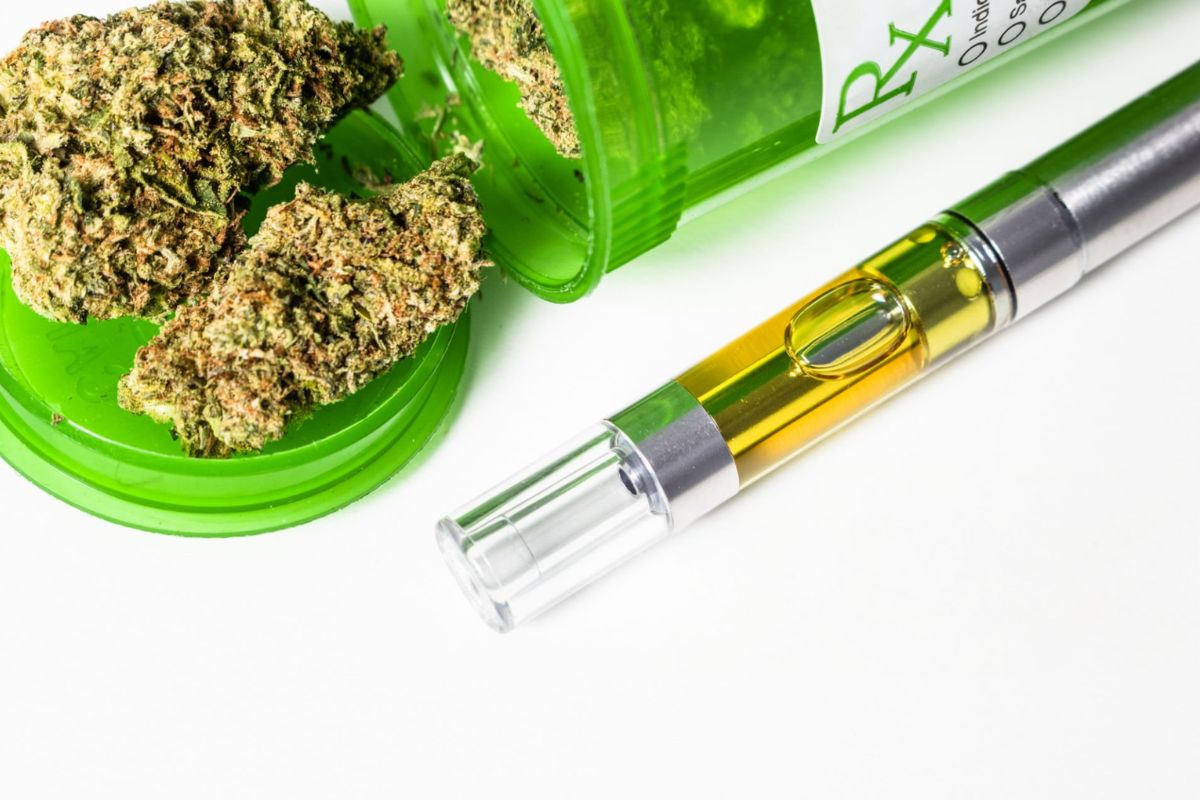
Regulation and industry standards play a vital role in ensuring the safety, quality, and consistency of THC vape cartridges and cannabis oil. Products that meet strict regulatory guidelines are more likely to contain properly tested cannabis oil free from harmful additives or contaminants.
These regulations also help ensure that vape cartridges are made with safe materials that won’t degrade under high temperatures or release toxic compounds during use.
When shopping for cannabis vape products, always look for signs of regulatory compliance, such as certified lab results, verified THC content, and clear ingredient labeling. Packaging should include information like expiration dates, batch numbers, and health warnings, all of which indicate that the product has been tested and approved under current standards.
This is especially important in preventing exposure to potentially dangerous counterfeit products and low-quality vape carts. By understanding and supporting regulation in the cannabis industry, consumers can make more informed decisions and contribute to a safer vaping environment. Promoting the importance of proper standards not only improves the vaping experience but also protects public health as the cannabis market continues to grow.
Understanding Shelf Life of Vape Cartridges
The shelf life of THC vape cartridges depends heavily on storage conditions and how well they are maintained. Over time, exposure to air, heat, and light can cause the cannabis oil inside to oxidize, leading to a dark brown color, reduced potency, and altered flavor.
Most cartridges have an expiration date, which indicates how long the oil is expected to stay fresh and effective when stored properly. Keeping cartridges in a cool, dark, and dry place helps extend their shelf life by preventing oxidation and degradation. Using cartridges beyond their shelf life can lead to a less enjoyable vaping experience and potential health risks.
Effects of Temperature Settings on THC Vape Oil
| Temperature Range | Effects on THC Oil | Flavor Profile | User Experience |
|---|---|---|---|
| Low (315°F–350°F) | Preserves most terpenes, low THC vaporization, smoother hit | Rich in natural flavors | Mild effects, great for flavor-focused sessions |
| Medium (350°F–390°F) | Balanced terpene and cannabinoid release, efficient THC vaporization | Moderate flavor, more vapor | Stronger high, more psychoactive effects |
| High (390°F–430°F) | Maximizes THC release but may degrade some terpenes | Less flavor, denser clouds | Intense high, quicker onset, harsher throat hit |
| Very High (430°F+) | Risk of combustion, can produce harmful byproducts, degraded oil quality | Burnt or bitter | Possible health risks, not recommended |
Temperature settings play a critical role in how cannabis vape cartridges perform. High temperatures can cause the THC oil to break down, resulting in a burnt taste and a loss of cannabinoids and terpenes that contribute to flavor and potency. On the other hand, vaping at lower temperatures helps preserve these compounds, delivering a smoother, more flavorful, and potent experience.
Many vape pens allow users to adjust temperature settings to optimize vapor production and avoid dry hits or overheating. Understanding the right temperature range for your specific cartridge can significantly improve the overall vaping experience and reduce the risk of inhaling harmful byproducts.
Recognizing Signs of Expired or Degraded Vape Cartridges
Expired or degraded vape cartridges often show clear signs that they should no longer be used. The oil inside may turn dark brown or cloudy, which is usually a result of oxidation or contamination. Users may also notice a burnt taste, reduced vapor production, or clogging in the cartridge. These symptoms indicate that the oil has lost potency and that harmful chemical changes may have occurred.
Continuing to use expired cartridges not only diminishes the vaping experience but also poses potential health risks due to inhaling degraded compounds. Regularly checking the color, flavor, and vapor quality of your vape cartridge helps ensure you are consuming safe, effective cannabis concentrates.
The Role of Carrier Liquids in Cannabis Vape Oil

Carrier liquids like vegetable glycerin (VG) and propylene glycol (PG) are commonly added to cannabis vape oils to achieve the right viscosity and improve vapor production. These substances help the oil flow smoothly through the vape pen’s heating element and create visible vapor clouds.
However, carrier liquids can also affect the flavor and overall vaping experience. While VG tends to produce thicker vapor with a slightly sweet taste, PG is thinner and offers a stronger throat hit. It’s important to choose vape cartridges that use high-quality carrier liquids to avoid potential health risks associated with low-grade or synthetic additives.
Understanding the role and quality of these carriers helps users select safer, more enjoyable cannabis vape products.
Understanding Dry Hits and How to Prevent Them
A dry hit occurs when the heating element in a vape pen burns the wick or oil due to insufficient liquid or excessive heat, producing an unpleasant burnt taste and harsh vapor. This often happens if the cartridge is low on oil, the coil heats too quickly, or the temperature setting is too high.
Dry hits not only ruin the vaping experience but can also expose users to harmful byproducts of combustion. Regularly checking oil levels, using proper temperature settings, and maintaining the vape pen’s coil and wick can help prevent dry hits and ensure smooth, flavorful vapor with every puff.
Why Proper Packaging and Labeling Matter in Vape Cartridges
| Aspect | Importance |
|---|---|
| Safety Assurance | Prevents contamination and ensures tamper-evidence. |
| Legal Compliance | Meets federal and state regulations for THC content and warnings. |
| Brand Credibility | Professional labeling builds trust and reflects quality. |
| Product Identification | Helps consumers distinguish between strains, potencies, and flavors. |
| Usage Instructions | Guides users on proper dosing and device compatibility. |
| Child-Resistant Features | Protects minors by meeting safety standards. |
| Expiration & Batch Info | Ensures freshness and traceability in case of recalls or complaints. |
| Marketing & Appeal | Attractive packaging influences purchasing decisions. |
| THC/CBD Content Transparency | Allows users to make informed choices about potency and effect. |
| Avoids Misuse | Clear labeling prevents accidental overuse or wrong application. |
The quality of THC carts depends on a few factors: the type of cannabis oil, cartridge material, extraction method (like using carbon dioxide), and other factors such as how the cart was packaged and stored. Poor-quality or counterfeit products can lead to a harsh or burnt taste.
Proper packaging and clear labeling are critical indicators of a high-quality THC vape cartridge. Authentic products typically include batch numbers, lab test results, ingredient lists, and expiration dates on their packaging. This transparency allows consumers to verify product safety and potency.
Packaging also helps protect the cartridge from environmental factors like air and moisture that can degrade the oil inside. Conversely, poorly packaged or unlabeled cartridges are often red flags for counterfeit or low-quality products, which carry increased health risks and inconsistent vaping performance.
Choosing well-packaged cartridges from reputable brands supports a safer and more reliable cannabis consumption experience.
Additional Resources
For reliable information on vape cartridge safety and quality, trusted sources like the FDA and CDC websites offer valuable guidance on vaping risks, regulations, and best practices. These organizations provide up-to-date research and educational materials to help consumers understand potential health implications and how to use vape products responsibly.
Exploring educational guides on vape cartridge usage, maintenance, and storage can further enhance your vaping experience by preventing common issues such as oxidation, dry hits, or burnt taste. Staying informed about proper handling techniques ensures that your cannabis consumption remains both enjoyable and safe.
Supporting regulatory efforts and keeping up with the latest developments in cannabis vaping technology and research empowers users to make well-informed decisions. Regularly reviewing credible sources helps you stay aware of potential risks, product recalls, and innovations in THC oil and vape cartridge quality.



